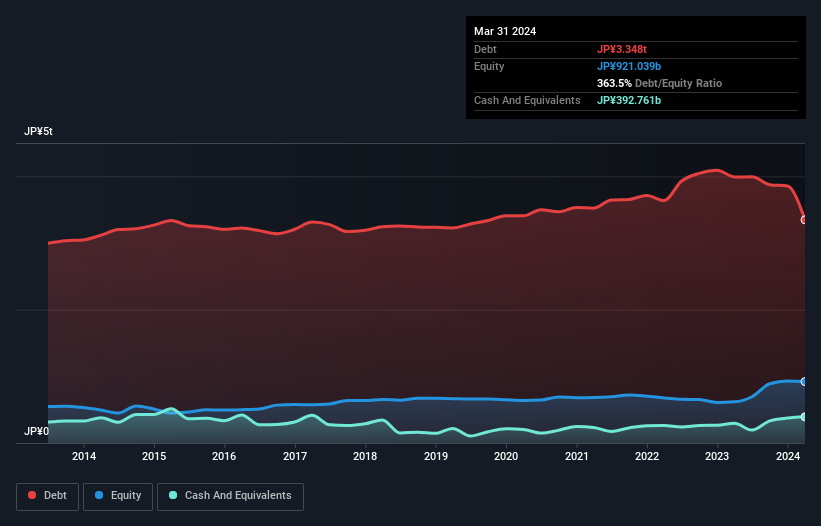
David Iben put it well when he said, 'Volatility is not a risk we care about. What we care about is avoiding the permanent loss of capital.' When we think about how risky a company is, we always like to look at its use of debt, since debt overload can lead to ruin. As with many other companies Kyushu Electric Power Company, Incorporated (TSE:9508) makes use of debt. But the real question is whether this debt is making the company risky.
What Risk Does Debt Bring?
Debt is a tool to help businesses grow, but if a business is incapable of paying off its lenders, then it exists at their mercy. If things get really bad, the lenders can take control of the business. However, a more usual (but still expensive) situation is where a company must dilute shareholders at a cheap share price simply to get debt under control. Of course, debt can be an important tool in businesses, particularly capital heavy businesses. When we examine debt levels, we first consider both cash and debt levels, together.
Check out our latest analysis for Kyushu Electric Power Company
What Is Kyushu Electric Power Company's Net Debt?
As you can see below, Kyushu Electric Power Company had JP¥3.35t of debt at March 2024, down from JP¥3.99t a year prior. However, it also had JP¥392.8b in cash, and so its net debt is JP¥2.95t.

A Look At Kyushu Electric Power Company's Liabilities
We can see from the most recent balance sheet that Kyushu Electric Power Company had liabilities of JP¥1.12t falling due within a year, and liabilities of JP¥3.69t due beyond that. Offsetting this, it had JP¥392.8b in cash and JP¥179.9b in receivables that were due within 12 months. So its liabilities total JP¥4.23t more than the combination of its cash and short-term receivables.
This deficit casts a shadow over the JP¥869.6b company, like a colossus towering over mere mortals. So we'd watch its balance sheet closely, without a doubt. At the end of the day, Kyushu Electric Power Company would probably need a major re-capitalization if its creditors were to demand repayment.
In order to size up a company's debt relative to its earnings, we calculate its net debt divided by its earnings before interest, tax, depreciation, and amortization (EBITDA) and its earnings before interest and tax (EBIT) divided by its interest expense (its interest cover). The advantage of this approach is that we take into account both the absolute quantum of debt (with net debt to EBITDA) and the actual interest expenses associated with that debt (with its interest cover ratio).
Strangely Kyushu Electric Power Company has a sky high EBITDA ratio of 5.9, implying high debt, but a strong interest coverage of 10.5. So either it has access to very cheap long term debt or that interest expense is going to grow! We also note that Kyushu Electric Power Company improved its EBIT from a last year's loss to a positive JP¥255b. There's no doubt that we learn most about debt from the balance sheet. But ultimately the future profitability of the business will decide if Kyushu Electric Power Company can strengthen its balance sheet over time. So if you're focused on the future you can check out this free report showing analyst profit forecasts.
Finally, while the tax-man may adore accounting profits, lenders only accept cold hard cash. So it is important to check how much of its earnings before interest and tax (EBIT) converts to actual free cash flow. During the last year, Kyushu Electric Power Company generated free cash flow amounting to a very robust 99% of its EBIT, more than we'd expect. That puts it in a very strong position to pay down debt.
Our View
While Kyushu Electric Power Company's level of total liabilities has us nervous. For example, its conversion of EBIT to free cash flow and interest cover give us some confidence in its ability to manage its debt. We should also note that Electric Utilities industry companies like Kyushu Electric Power Company commonly do use debt without problems. Taking the abovementioned factors together we do think Kyushu Electric Power Company's debt poses some risks to the business. While that debt can boost returns, we think the company has enough leverage now. The balance sheet is clearly the area to focus on when you are analysing debt. But ultimately, every company can contain risks that exist outside of the balance sheet. To that end, you should learn about the 4 warning signs we've spotted with Kyushu Electric Power Company (including 2 which are a bit concerning) .
At the end of the day, it's often better to focus on companies that are free from net debt. You can access our special list of such companies (all with a track record of profit growth). It's free.
Valuation is complex, but we're here to simplify it.
Discover if Kyushu Electric Power Company might be undervalued or overvalued with our detailed analysis, featuring fair value estimates, potential risks, dividends, insider trades, and its financial condition.
Access Free AnalysisHave feedback on this article? Concerned about the content? Get in touch with us directly. Alternatively, email editorial-team (at) simplywallst.com.
This article by Simply Wall St is general in nature. We provide commentary based on historical data and analyst forecasts only using an unbiased methodology and our articles are not intended to be financial advice. It does not constitute a recommendation to buy or sell any stock, and does not take account of your objectives, or your financial situation. We aim to bring you long-term focused analysis driven by fundamental data. Note that our analysis may not factor in the latest price-sensitive company announcements or qualitative material. Simply Wall St has no position in any stocks mentioned.
About TSE:9508
Kyushu Electric Power Company
Engages in the power generation, transmission, distribution, and retail in Japan and internationally.
Second-rate dividend payer low.
Market Insights
Community Narratives



